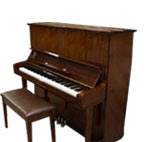 Austrian composer Johann Strauss surpassed his father, Johann Strauss the Elder’s popularity and productivity, becoming known as the “Waltz King.”
Austrian composer Johann Strauss surpassed his father, Johann Strauss the Elder’s popularity and productivity, becoming known as the “Waltz King.”
Synopsis
Johann Strauss, often referred to as Johann Strauss II, was born on October 25, 1825, in Vienna, Austria. His father, Johann Strauss the Elder, was a self-taught musician who established a musical dynasty in Vienna, writing waltzes, galops, polkas and quadrilles and publishing more than 250 works. Johann the Younger went on to write more than 500 musical musical compositions, 150 of which were waltzes, and he surpassed both his father’s productivity and popularity. Compositions such as The Blue Danube helped establish Strauss as “the Waltz King” and earned him a place in music history. He died in Vienna in June 1899.
Early Years
Johann Strauss, often referred to as Johann Strauss II or “the Younger,” was born on October 25, 1825, in Vienna, Austria. He was the oldest son of Johann Strauss (the Elder), also a composer, but one whose reputation would eventually be eclipsed by his son’s.
Strauss the Elder wanted his son to follow a different career path than he himself had followed, so Strauss II became a bank clerk while secretly studying the violin with a member of his father’s company. His father left the family when Strauss was 17, and Strauss soon began openly embracing the musician’s life, conducting a band in a Viennese restaurant when he was still a teenager, in 1844.
The Musician
A year after the restaurant appearance, Johann Strauss formed his own band and suddenly found himself competing with his father. He also began writing at this point—quadrilles, mazurkas, polkas and waltzes, which were then performed by his orchestra. He soon began receiving praise for his work and, in 1845, was awarded the honorary bandmaster position of the 2nd Vienna Citizens’ Regiment. (To shed some light on the competition between father and son, Strauss the Elder was bandmaster of the 1st regiment.)
Strauss began composing for the Vienna Men’s Choral Association in 1847. His father died two years later, prompting him to conflate his own and his father’s orchestras, after which he mounted a successful career. In 1853, Strauss fell ill, and his younger brother, Josef, took control of the orchestra for six months. After recovering, he dove back into conducting and composing activities—a pursuit that proved to be stronger than ever, gaining the eventual attention of such luminaries as Verdi, Brahms and Wagner.
The Composer
The 1860s saw Strauss hit a few touchstone moments, as he married singer Henriette Treffz in 1862 and toured in Russia and England, extending his reputation. He would soon, however, quit conducting for the most part (exceptions being engagements in New York City and Boston in 1872) to focus on writing music, turning his orchestra over to his two brothers, Josef and Eduard. Strauss’s focus in composition was dual: the Viennese waltz and the Viennese operetta, and he would become renowned for the former. His operettas include Indigo und die vierzig Räuber (1871; his first) and Die Fledermaus (1874), which would become his most famous. But his waltzes—of which there were 150, less than a third of his total output—would have truly lasting appeal.
An der schönen blauen Donau (The Blue Danube; 1867) would be the piece that defined Strauss to the listening public, and the work still resonates 150 years later. Other Strauss waltzes include Morgenblätter (Morning Papers; 1864), Geschichten aus dem Wienerwald (Tales from the Vienna Woods; 1868) and Wein, Weib und Gesang (Wine, Women and Song; 1869).
Later Years
On the heels of his American tour and his international rise, Strauss encountered his share of loss in the 1870s: His mother and brother Josef died around the same time, and his wife died of a heart attack in 1878. Strauss married two more times and remained productive right up until his final days. He was working on a ballet, Cinderella, when a respiratory illness turned into pneumonia and caused his death, on June 3, 1899, in Vienna.









